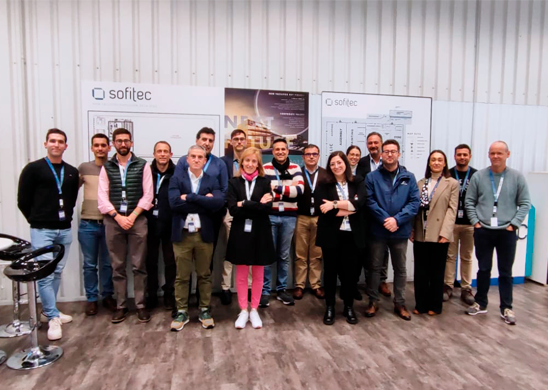
The evolution of non-destructive testing in the context of Industry 4.0: An interview with Dr. Jose Luis Lanzagorta
In the constant quest to improve efficiency, safety and quality in industry, Non Destructive Inspection Technologies (NDT) are playing a pivotal role. Over the years, NDT technology has witnessed unprecedented evolution, but at the dawn of the 4.0 era, a new wave of innovation has transformed the NDT landscape in astonishing ways.
We had the opportunity to sit down with Dr. José Luis Lanzagorta from the IDEKO technology centre, a researcher in the field of NDT techniques and an expert in the implementation of advanced technologies in this field. Lanzagorta will guide us through the challenges and opportunities that have arisen in the industry on its way to the 4.0 era.
/ What are the main technological developments in the NDT world due to the digital transformation associated with 4.0 environments?
The evolution of NDT techniques in 4.0 environments has focused in recent years on the development of new tools to improve access to and use of data to optimise both inspection and manufacturing processes. Thanks to digitisation and connectivity, data collected during non-destructive testing has taken on a new dimension in terms of availability and analysis.
At the same time, the transformation of NDT results into useful information for operators and quality inspectors has been a key part of this evolution. Instead of simply obtaining isolated readings and results, more detailed and contextualised information can now be provided thanks to the application of advanced algorithms. This includes the automatic and accurate location of the detected defect, as well as the characterisation of the defect, providing details on its dimensions, type and level of severity. This wealth of data enables a deeper understanding of the problems identified and helps professionals make informed decisions in real time.
Artificial intelligence (AI) has played a key role in the interpretation of NDT data, especially when dealing with signals associated with complex defects. In situations where signals may be inconclusive or difficult to analyse manually, AI-based algorithms have proven to be of great relevance. These algorithms can identify subtle patterns and perform advanced analysis, providing operators with a deeper understanding of the situation and assisting in making critical decisions.
/ How has automation and digitalisation impacted the efficiency and accuracy of non-destructive testing?
The automation of inspection systems had a big impact on the solutions developed in the early 2000s, where complex and highly competitive solutions began to be created.
The advent of digitalisation has further boosted NDT solutions, especially when a large amount of data associated with high value-added components needs to be collected. One of the challenges is how to collect the information in an autonomous, orderly and structured way, so that it is then available to inspectors or plant operators. In addition, it is important to apply optimised data analysis strategies to make the most of the information acquired during the inspections carried out. All of this is focused on obtaining more accurate, faster inspections that are less dependent on the operator’s expertise.
/ What are the advantages and challenges of implementing NDT techniques in digital environments compared to traditional methods?
Without a doubt, the adoption of NDT techniques in 4.0 environments has multiple advantages that significantly improve industrial operations. Firstly, there is the reliability, the enhanced detection capability that 4.0 technology offers. Automated systems and advanced algorithms make it possible to detect defects more accurately and earlier, reducing the risk of false negatives and increasing operational safety.
In addition, processes become more autonomous and traceable thanks to optimised data management. Digitisation facilitates the collection, storage and analysis of information in real time, enabling more agile decision-making based on solid data.
Furthermore, NDT techniques in 4.0 environments are not limited to detecting defects, but use the data obtained to close feedback loops and optimise processes. The information generated by inspections becomes a valuable resource for improving quality, efficiency and productivity in the manufacture of components and structures.
Despite all the advantages, the transition to the application of NDT techniques in 4.0 environments is not without its challenges. One of the main ones is adapting to this new way of carrying out inspections. Both end users and operators must adjust to innovative technologies and methodologies. This requires a learning curve and an open mind to take full advantage of the capabilities of the new tools.
It is important to note that the implementation of NDT techniques in 4.0 environments does not seek to eliminate or dispense with the operator. On the contrary, their knowledge and expertise remain essential to ensure the quality of components. The collaboration between advanced technology and the inspector becomes essential for optimal and safe inspection results.
/ What are the key technologies used in NDT in 4.0 environments?
There are several technologies that have emerged as key pillars to improve and enrich the inspection and defect characterisation process. However, I would highlight the combination of Data Analytics, Artificial Intelligence and the Internet of Things (IoT).
The use of Data Analytics has transformed the way operators handle large volumes of data and make crucial decisions. Previously, they faced the challenge of analysing signals without conclusive support. Now, thanks to advanced Data Analytics techniques, they can perform these tasks faster and more efficiently. Most interestingly, with advances in IoT, operators can perform these tasks from anywhere in the world and share data with their colleagues to make critical decisions in a collaborative and consensual manner. This has resulted in a more integrated and global data architecture.
In addition, as I mentioned earlier, AI algorithms have the ability to identify subtle patterns and perform advanced analytics, giving operators a deeper understanding of the situation and assisting them in making critical decisions.
/ How have the equipment and devices used in NDT in digital environments evolved to adapt to new technological demands and requirements?
Due to increasing quality requirements, it is becoming more and more necessary to develop specific sensors that adapt to customer needs. At this point, the knowledge and development of simulation models is becoming more and more important in order to produce sensors with the best performance..
NDT hardware systems in fields such as ultrasound and eddy current have undergone major advances in recent years to meet the needs of the new 4.0 manufacturing environments. For example, equipment has been equipped with more advanced communication protocols that allow NDT data to interact with data from other elements that make up the complete inspection system, such as robots or mechanical systems..
NDT software is increasingly equipped with more advanced tools for post-processing NDT data, including in some cases the introduction of AI-based tools.
However, not all problems are solved, and it is necessary to customise the capabilities of both the equipment, according to customer needs and inspection requirements. In this sense, companies such as Endity provide a differential value by applying their knowledge and know-how in this type of projects.
/ What is the role of data and analytics in NDT in digital environments and how are they used to improve decision-making and asset management?
Data and analytics play a crucial role in NDT in 4.0 environments. Collecting data in an orderly and structured way allows for more efficient and reliable inspection. By organising data properly, accurate traceability of the inspected component is achieved, which is essential for future reference or follow-up. Furthermore, the structuring of the data facilitates the evaluation of the component, as the results can be analysed systematically and comprehensively.
Data post-processing is a critical step in NDT techniques. By analysing the collected data in detail, the maximum possible information can be obtained from the inspections performed. This includes determining the number of defects present and their level of severity on the component.
The application of advanced algorithms in NDT has been a major breakthrough. These algorithms make it possible to obtain the most important key performance indicators (KPIs) of the inspection. By translating the data into useful and relevant information, operators and inspectors can make fact-based decisions more accurately and efficiently.
/ What are the implications of NDT in digital environments in terms of safety, quality and productivity in different industries?
By applying NDT in 4.0 environments, more accurate and detailed results on defect characteristics are achieved. This, in turn, significantly improves decision-making and leads to a significant improvement in the quality of manufacturing processes, resulting in parts with fewer defects. Furthermore, by eliminating the human factor, inspection results become completely objective, which increases safety and objectivity in data analysis.
In terms of productivity, the implementation of increasingly autonomous systems, such as endity’s e-blade, for example, has a direct impact on increasing efficiency. Inspection times are considerably reduced by obtaining more accurate and objective data, which contributes to a significant improvement in the efficiency and overall performance of industrial processes.
/ How is NDT expected to evolve in the coming years and what are the future trends and challenges?
As in the rest of the manufacturing processes, the role of AI tools or digital twins appears to be the biggest challenge in this area. All of this is focused on freeing the operator from more rudimentary tasks and focusing them on operations with greater added value, applying their experience.
From the point of view of automation, the aim is to obtain more autonomous and less complex solutions that allow greater performance and productivity in inspection processes.
Finally, NDT techniques will play a key role in companies’ sustainability and circularity strategies, providing useful information in terms of resource savings and carbon footprint reduction.
endity



